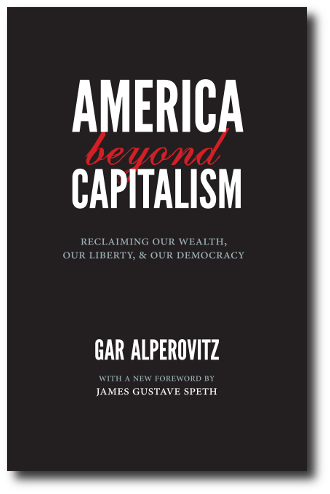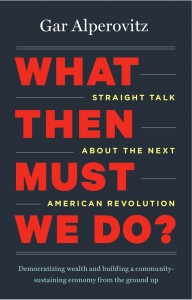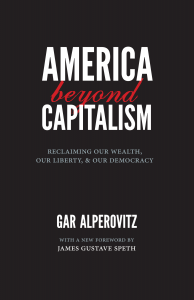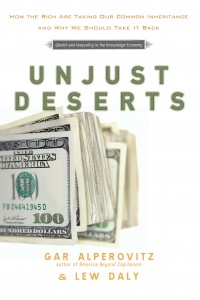 Published in the May/June & July/August 2014 issue of Orion magazine
Published in the May/June & July/August 2014 issue of Orion magazine
IN THE MID-1960s, when author, historian, and political economist Gar Alperovitz was working as legislative director for Senator Gaylord Nelson, change was in the air. Ink had dried on an early version of the Clean Air Act, the civil rights movement had won major victories, and the first Earth Day was in the works. The U.S. still faced plenty of serious challenges, but many Americans felt their country was capable of dealing with them successfully.
Today, things feel very different. “From climate change to a medieval level of wealth disparity, what we face in this country is no longer a regulatory crisis,” says Alperovitz. “We face a systemic crisis. And if you begin there, you begin to wonder: Is capitalism itself in profound trouble?”
Alperovitz believes it is. The author of several books on the subject, including America Beyond Capitalism, and a professor of political economy at the University of Maryland, he points to capitalism’s increasing dysfunction as the impetus for the rise of another economy, one built from the ground up by democratically owned organizations like cooperatives, community land trusts, and municipal institutions.
Orion editor Scott Gast spoke with Alperovitz after the publication of his most recent book, What Then Must We Do?: Straight Talk About the Next American Revolution, which explores whether the cooperative economy can provide the seeds for a system that isn’t capitalism and isn’t socialism, but something entirely new.
SCOTT GAST: You’ve been thinking, writing, and speaking about alternatives to capitalism for a long time. Where did your interest in cooperatives begin?
GAR ALPEROVITZ: My interest began back in 1977, when a big steel company, Youngstown Sheet and Tube, went out of business. Five thousand people in Youngstown, Ohio, lost their jobs in one day, which was disastrous. Layoffs of that size are common today—especially when multinational corporations shift capital around—but in 1977 that was front-page, national news. It was a big, big deal.
But the community leaders and steel workers in Youngstown decided that they didn’t have to go down without a fight. They got together and built a coalition to buy the steel mill back and run it themselves, under worker-community ownership. They began organizing locally and statewide, and soon the Carter administration agreed to provide funds to hire experts who could help them with the mill’s technical designs.
Things were looking up until the mid-term election of 1978, after which the Carter money disappeared and the project fell apart. It was a serious blow—but everybody involved in the coalition knew it might happen. They understood that part of their job was to educate people about this alternative form of ownership, because what happened in Youngstown was going to happen to other communities, and at some point, they might win the battle. So they launched an educational campaign throughout Ohio, and they began talking about worker and community ownership as a means of rescuing cities and towns from decay.
So even though the Youngstown experiment failed, it succeeded in a much larger sense: Some thirty-five years later, there are now a great many worker-owned businesses in the state of Ohio, and the support system for building them is one of the best in the nation. We don’t know the exact number, but very large numbers, per capita, in Ohio, are traceable to this education effort.
SCOTT: What exactly is a worker-owned company? What makes them different from conventional businesses?
GAR: A worker-owned company, or cooperative, is essentially a one-person one-vote, member-owned and -controlled economic institution or business. Included in the American cooperative experience are agricultural co-ops, insurance co-ops, food co-ops, housing co-ops, health-care co-ops, artist co-ops, electrical co-ops, credit unions, and many more. Large retail co-ops many Americans are familiar with include REI, the outdoor clothing and supply company, and ACE, the hardware-purchasing cooperative.
The modern cooperative form is often dated back to the Rochdale Society of Equitable Pioneers founded in England during the 1840s, although other cooperative economic arrangements have existed throughout human history. At roughly the same time, in the United States, cooperatives were being formed by both the National Trades’ Union and the associationist movement. And many farm co-ops date from the 1930s and the New Deal.
But aside from being owned by members rather than by shareholders or individuals, cooperatives differ from many traditional businesses in their values and motives. Also, they’re not required to grow, but they can and do, which is important in terms of designing an alternative to capitalism, because we need to get beyond the existing economy’s drive to use resources and produce waste, including carbon emissions, in ever-increasing quantities.
SCOTT: Does worker and community ownership exist in forms other than cooperatives?
GAR: Yes, these institutions come in several varieties—from employee stock ownership plans to municipal enterprises and community land trusts.
In employee stock ownership plans, voting rights are retained by a trust, not by the workers. These organizations commonly create worker ownership via special tax incentives given to the companies’ heads, who then decide to sell the company to their employees. These are by far the most prevalent form of worker ownership in the United States; there are now roughly eleven thousand of them. More than 10 million people are involved as owners in virtually every sector; some firms are very large and sophisticated, such as Publix Super Markets, while others are more modest in size.
Municipal enterprises—or businesses owned by local governments—are a larger-scale form of democratized ownership. Local governments often operate utility companies, help build telecommunications and internet infrastructure, and invest in mass transit. Increasingly, city governments have turned to these enterprises to promote local jobs and economic stability.
Land trusts are a third form. Essentially nonprofit corporations, they own housing and other property in ways that prevent destructive gentrification and support low-income housing. In 2012, 255 community land trusts were operating in forty-five states and the District of Columbia.
SCOTT: You mentioned earlier that, in the wake of the Youngstown Sheet and Tube collapse, there are a great many worker-owned companies in Ohio. Can you describe one of them?
GAR: In Cleveland’s Glenville neighborhood—which is a poor, mostly black neighborhood with high unemployment and an average income of about $20,000—there exists a complex of worker owned companies called the Evergreen Cooperatives.
Evergreen is not a collection of small co-ops; these are significant scale companies linked together with a nonprofit community corporation, and they employ many local people. The largest urban greenhouse in the United States, Green City Growers Cooperative, is one of the companies in the complex, and it’s capable of producing 3 million heads of lettuce a year, plus other greens. There’s also Evergreen Cooperative Laundry, which is an industrial scale laundry serving hospitals and nursing homes in the area; they’re housed in a LEED-certified building and use about a third of the heat and a third of the water of ordinary laundries. And there’s a solar installation company, Evergreen Energy Solutions, which employs men and women from inner-city Cleveland and recently installed a forty-two-kilowatt solar unit on the roof of the Cleveland Clinic.
But what makes this complex particularly interesting is the way it’s anchored to its community: In the middle of this very poor neighborhood, there are two major hospitals. The Cleveland Clinic is one; University Hospitals, the other one, is attached to Case Western Reserve University. Together, those institutions purchase about $3 billion—that’s billion with a b—in goods and services a year, which, until recently, were purchased almost entirely outside the community. Now, though, they’ve begun to direct some of that purchasing power at this complex of cooperatives.
In this model, those big, quasi-public institutions are called “anchor institutions.” Unlike major corporations, they don’t get up and leave; they’re anchored to their neighborhoods, and they drive the local economy.
SCOTT: Surely, though, those anchor institutions are looking to purchase goods and services at a low price. What’s to prevent a corporation—like Walmart—from moving to the edge of town and undercutting the local cooperatives by selling the same stuff for less? In other words, how can a cooperative economy survive the mainstream market economy?
GAR: Well, in addition to their relationships with anchor institutions, some co-ops are beginning to buy from each other in order to widen and stabilize their markets. For instance, I’ve just been down to Texas, where there’s work being done to build a system of co-ops that buy from other co-ops, which in turn sell to regional public school systems. In general, as these co-op complexes group together, and get more sophisticated, they also become better able to withstand pressure from the market economy.
A stable market also means that growth isn’t a requirement, which is important in terms of environmental sustainability. Usually, it’s fear of instability or being undercut that drives a firm’s desire to grow: if somebody else invests in a new machine that makes things a little bit cheaper than you can, you either invest and grow enough of your market to pay for the machine, or you’re out of business. What that means is companies eat each other up; the winning company displaces the losers, and the losers are thrown away.
SCOTT: But isn’t some degree of competition between companies healthy?
GAR: Absolutely—to a point. But community stability is important too. And the current economy isn’t providing it. Which has been disastrous for many reasons. For instance, Cleveland was once home to more Fortune 500 corporation headquarters than perhaps any city other than New York. Today, almost all of them are gone. The city’s population has gone from 900,000 to under 400,000, all because the economic decision making power was left to corporations, leaving the city vulnerable. It’s a wasteland now—we’ve thrown away the houses, schools, and local businesses for 500,000 people. Which comes with huge carbon costs. It’s even worse in Detroit, where a million people have been forced out. And people don’t disappear; they need houses and hospitals and schools someplace else.
All of this is very, very costly to people and places, which means that there is an incentive, if you do it the right way, to begin stabilizing these communities and their local economies.
SCOTT: What’s going on in Cleveland seems to represent something more sophisticated than the traditional corner-store grocery co-op. These businesses are nurturing a set of ideas as well as providing products and services.
GAR: That’s right. Taken together, these efforts are beginning to address one of the fundamental questions at the heart of our many crises, which is, who controls wealth?
Throughout history, controlling wealth is a big part of controlling politics and, as a result, making decisions about the future. And the richest four hundred people in America have more wealth than the bottom 180 million. So the efforts in cities like Cleveland to change patterns of wealth ownership at small and medium scales, local and regional scales, are very important in terms of building political power. They’re doing it at the neighborhood scale, through cooperative forms, and within an ecologically intelligent context.
In contrast to corporations, which have every interest in cutting costs wherever possible, locally rooted cooperative institutions are inherently responsible to people and place. They give local people a stake in the enterprise, which means that the health of the community comes first. Local people have good jobs, and the land, air, and water are treated with care.
SCOTT: Why are these forms proliferating now? What’s driving the experimentation?
GAR: In a word, pain. Many communities are simply not able to deal with their employment problems. In a city like Cleveland, or in any major city for that matter, the typical pattern for employment is, “Major corporation seeks major subsidies to come into the city, while attempting to avoid regulation wherever possible because it’s costly.” The city’s in a box, because it needs to provide jobs, and so it’s forced to cut corners and make a deal.
Communities need alternatives to these difficult confrontations with corporations. Without them, many are simply decaying, and unless they try something new, things are likely to get worse. And so we’re finding, all over the country, attempts to draw on the experience of cities like Cleveland and its experiment with worker-owned complexes.
SCOTT: What are some examples of this kind of thing—the Cleveland model—at work elsewhere in the country?
GAR: In Boulder, Colorado, there is a major city effort to take over a large electric utility, which up to this point has been run by a private energy corporation. It’s part of an effort to move away from polluting forms of energy and toward solar and other renewables. So far, the successes have been hard fought. Activists in Boulder realized corporate regulation was hopeless, so they’ve helped their city fight for ownership of the utility. They recently won by a large majority in a second referendum and, as a result, are continuing to move away from fossil fuels.
People in Boulder have recognized that attempting to regulate corporations while leaving ownership in their hands also leaves the power in the hands of that institution. But making their utility municipal—which is a form of democratization—gives decision-making power back to the community.
There are literally hundreds of experiments going on at different levels that point to changes in ownership as a way to build new institutions—institutions that emerge from a more locally minded set of values. The Cleveland model is proliferating all over the country—there’s an effort like it in Atlanta, three in the Washington DC area, one in Pittsburgh, one in Cincinnati, a new one in the Bronx. Most people don’t realize that 25 percent of American electricity is provided by municipal ownership or co-ops, and much of it in the traditionally conservative South.
SCOTT: How many people and how much capital are involved in cooperative institutions?
GAR: There are around 130 million Americans who are members of co ops. The credit union sector, which is part of the co op sector, has more or as much capital as any one of the big five New York banks. The nonprofit sector is about 10 percent of the economy. And you can add in employee stock ownership plans, municipal enterprise, and community land trusts.
At a slightly larger level, twenty states have introduced legislation to create publicly owned banks. The Bank of North Dakota, for example, which has been a state owned bank for about one hundred years, puts the public in control of investing, and has been very popular among residents.
All of this is part of a larger movement toward democratically controlled and owned pieces of the economy, which is slowly building new institutions and infusing them with a different culture, ethic, and environmental concern.
SCOTT: If these activities manage to continue, and to keep growing, what’s next? Can some kind of critical mass be reached, at which point an alternative economic system presents itself to average Americans?
GAR: We’re talking about building a foundation of ideas and culture, which can then begin to command political power. That’s what occurred during the time of the Progressive movement, the women’s movement, the populist movement, and the civil rights movement.
There’s also something very American about the bottom-up process at work here. It doesn’t look anything like the old, state-centric European model. It begins instead by asking, What can you do in your neighborhood? What can you do in your city? Can you build at the neighborhood, city, and state levels a whole culture of institutions that sets the terms of reference for the larger order system?
SCOTT: What you’re describing reminds me in some ways of bioregionalism, the idea that human settlements and economies should be scaled according to distinct ecological regions.
GAR: Yes, I think scale is a very important aspect of this. We tend not to remember how gigantic the United States is compared with other countries: you could take the whole of Germany and drop it into the state of Montana. It’s very hard to organize a democratic politics in a system of that scale. Large corporations can dominate the media and dominate the capital city, as we’ve seen.
So the logic does point toward a regional structure of some kind: New England, the Pacific Northwest, the Upper Midwest. Or the state of California, which is itself a giant region. In fact, debates about this took place in the 1930s among liberals, conservatives, and radicals. The Tennessee Valley Authority, for example, began as a regional body oriented around a river system.
Still, though, we’ve got to think at both small and large scales. For instance, in the future, if anybody still wants to fly an airplane to get across the continent, or take a large train, the work of building planes or trains will likely not be done in one neighborhood. That kind of work requires larger, more sophisticated institutions, and we should be thinking about those, too.
SCOTT: Our country’s size, along with its concentration of political power, seems to inhibit progress on all sorts of issues, including climate change. Should we start small, then, and attempt to address that issue community by community, region by region?
GAR: As you’ve probably noticed, my bias is always to start at the smallest scale possible. Ultimately, unless the culture changes from the bottom-up, in a direction favorable to the ecological and community-oriented values we’re talking about—and I think there is movement in that direction—nothing is going to change.
But in terms of climate change, we’ll eventually have to deal with the problem of the giant corporation, because it’s corporate power that’s warped the political system. As we’ve seen, it’s all but impossible to regulate greenhouse gas emissions: corporations make the argument, particularly as the economy worsens, that they can’t sustain the cost of regulation. And so politics fail in this respect; emissions continue to expand.
It’s interesting to note that the economists at the Chicago School of Economics looked at the principle underlying this problem during the 1930s and 40s. The argument was made by the same people who taught Milton Friedman—the famously conservative economist—that in a free market, the power of the giant corporation is simply overwhelming. They are so powerful that they actually distort the market and trample competition. Remember, these were conservatives!
Later economists from the same school of thought argued that if you try to regulate, the large corporations will take over the regulators, because the corporations are more powerful than they are. And, going one step further than they did, we now know that even if the corporations are broken up via antitrust laws, they’ll simply regroup under another name, the big fish will eat the little fish, and pretty soon you’ll be back in the same place—that’s what happened with AT&T and with Standard Oil.
So these economists faced the dilemma directly: If you can’t regulate corporations because they’ll overpower the regulators, and if you can’t break them up, it was argued that the only option left is to make them into public corporations. It’s hard to call Milton Friedman’s teachers socialists, but in fact, that’s what some of them concluded.
In terms of climate change, where corporate power is a primary obstacle to meaningful change, I think we need to face the same answer—return the power concentrated in corporations to communities via public ownership. To get there, we need to build a culture that is less frightened of these ideas, a culture in which people experience, in their own lives, co ops, land trusts, municipal utilities—local, direct, participatory democracy.
SCOTT: Is what you’re describing—the democratization of wealth, beginning at the community level—a kind of socialism? That word, of course, is so loaded these days.
GAR: Well, it certainly wouldn’t be accurate to say that co ops in their current form—democratically owned economic institutions—are socialist entities. But a municipal utility might be called “socialist.” A neighborhood land trust owned by the neighborhood or controlled by a city could be called “socialist.”
So, yes, that charge can be leveled, but the key difference between what I’m describing and what most people think of as socialism is that, with socialism, ownership of wealth and power is traditionally concentrated within the state and its national government. The vision that’s emerging in these experiments around the country is anathema to that. It begins in neighborhoods and communities, in cities and states. It’s about decentralizing power, changing the flow of power to localities rather than to the center.
But I think the old worries about socialist rhetoric come out of the Cold War. The people under thirty who are going to build the next politics over the next three decades are looking for answers; I don’t think they’re much concerned about that old rhetoric. What’s most important is that the answers be practical. That’s what we’re finding. For instance, in Cleveland, the worker-owned complex is giving people jobs and a stake in the future of their communities.
Even conservatives have turned out to be supportive of these local experiments. People forget this, but Ronald Reagan, for instance, was a great proponent of worker-owned companies and is publicly on the record as believing they’ll be an important part of our future.
SCOTT: In your writing and speaking you’ve used the term “evolutionary reconstruction” to describe the work of the next several decades. What do you mean?
GAR: What I’m talking about is the reconstruction of a culture of community in this country. Neither simple reform of old institutions nor “revolution.” And that’s a project that depends not only on local-level work, but also on institution building and long-term cultural change. It’s not just about climate change or any other issue; it’s about re-conceiving ourselves as people who care about the country and want to move it in a different direction. I think younger people get that and understand it instinctively.
Through all of this, we should remember to think of ourselves as historical actors. We are facing systemic problems, like climate change, that are historic in scale. And you don’t change systems without thinking in terms of decades. Remember, big shifts happen all the time in world history: the American Revolution, the French Revolution, even the modern environmental movement. But all of these things were thirty or forty years in development before they exploded. That’s true of the civil rights movement: there were people in the 1930s and ’40s whose names we’ve never heard of who were developing a long-term vision that made possible what happened in the 1960s. Without that kind of a vision, there is no base for a larger change.
Developing a democratically oriented alternative to capitalism can’t be done overnight. This work requires a different sense of time and a deep sense of commitment—the bargaining chips are decades of our lives. But the shifts are already happening in places like Cleveland and Boulder. What we’re seeing is the prehistory, possibly, of the next great change, in which a movement is built from the grassroots that becomes the foundation of a new era.
 AMERICA BEYOND CAPITALISM
AMERICA BEYOND CAPITALISM



 Agenda
Agenda  Posterboard
Posterboard 